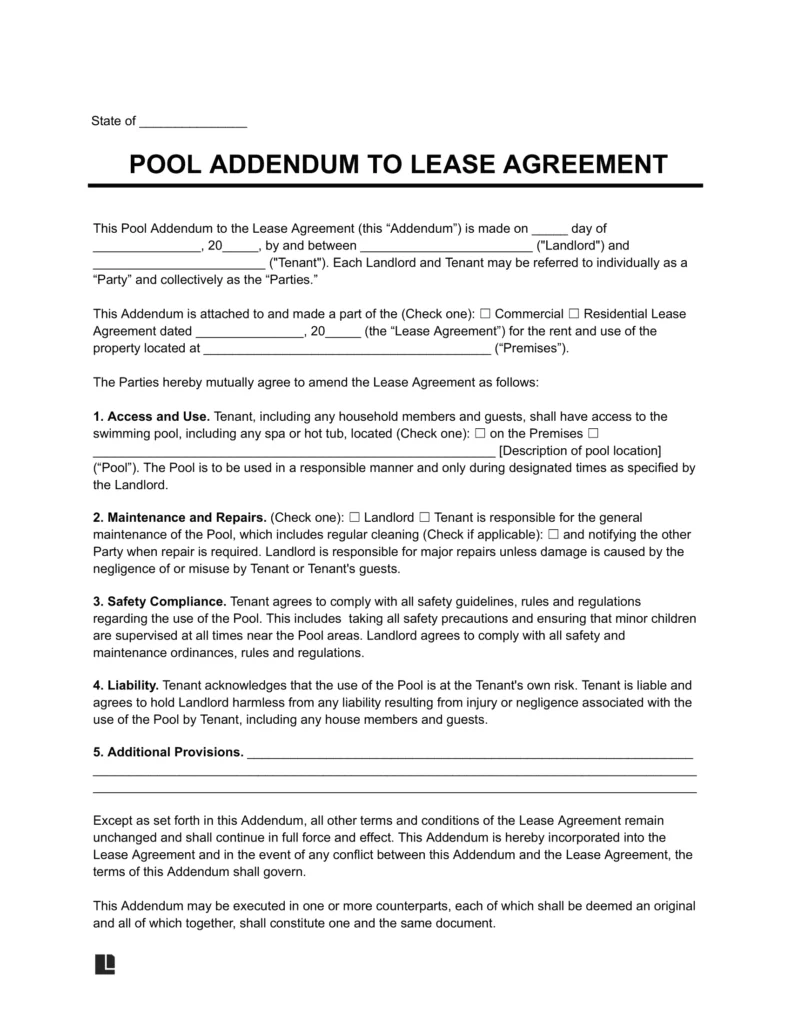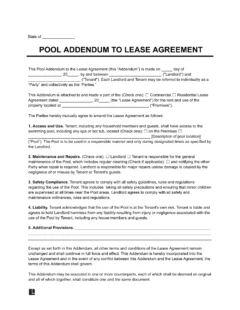Swimming Pool and Spa Lease Addendum Template
Use our Swimming Pool and Spa Lease Addendum to outline the terms related to the use, care, and maintenance of the swimming pool or hot tub.
Updated July 18, 2024
Written by Yassin Qanbar | Reviewed by Susan Chai, Esq.
A swimming pool and spa addendum is a supplemental document to a lease agreement that outlines the regulations concerning the use of a pool and/or spa on the premises. This addendum can apply to both private and communal swimming areas, including spas, hot tubs, or jacuzzis, and specifies who is responsible for regular maintenance.
Additionally, the addendum works to release the landlord of legal liability for injuries or damages related to the tenant or their guests’ use of the pool. Thus, the document serves two main functions: establishing usage rules and shielding the landlord from legal claims associated with pool-related incidents.
- State Laws and Regulations
- Landlord Considerations
- Tenant Guidelines
- Considerations for Both Single and Multi-Unit Properties
- Swimming Pool and Spa Lease Addendum Sample
What to Include in a Pool Addendum for Rental Agreement
At the outset, the addendum should present identifying details such as:
- Date
- Rental property address
- Tenant names
- Reference to the original lease
Following the intro, an essential section of the addendum should comprehensively cover obligations related to the pool and spa, including:
- Safety measures and usage hours.
- Guest policies.
- Age restrictions for unsupervised access.
- Specify maintenance responsibilities (landlord vs. tenant).
- Required tasks like cleaning and professional inspections.
- Safety requirements (fencing, pool covers, life-saving equipment).
- Detail emergency protocols to reduce accidents.
Download: PDF or MS Word.
State Laws and Regulations
Always follow the strictest pool fencing laws, whether they are federal or state. Check with local authorities like code enforcement or building inspectors to ensure compliance.
Local regulations may also apply, for example, Maryland’s Anne Arundel County offers specific guidelines on permits, safety, and requirements for residential pools.
For federal guidelines, refer to the Safety Barrier Guidelines for Residential Pools, which provide detailed information and visuals.
Please note that the following state laws are examples and not an exhaustive list. Many states have their own laws and regulations, including:
Arizona
Under the Arizona Residential Landlord-Tenant Law, landlords who rent a property with access to a swimming pool must provide the tenant with a pool safety notice (§ 36-1681(E)).
Arizona also aims to protect children under the age of six in homes with swimming pools, affecting both homeowners and renters. It requires a barrier, such as a wall or fence, around both above-ground and in-ground pools unless local regulations differ (§ 36-1681).
California
Beginning in September 2025, California will mandate that all newly sold pool pumps be internet-capable and programmed to run primarily between 9 AM and 3 PM. This requirement applies to those constructing new residential swimming pools or replacing existing pumps, although use outside these hours is permitted. The regulation excludes hot tubs (§ 1693).
Florida
Florida’s Residential Swimming Pool Safety Act, Chapter 515, establishes safety protocols for residential swimming pools. Barriers must be at least 4 feet high with no gaps and separate from other fences, not directly adjacent to the pool. Above-ground pools may use their structure as a barrier if it secures access points.
Gates should open outward, be self-closing and latching, with child-proof release mechanisms. The home’s walls can be part of the barrier if unclimbable, and no nearby structures should allow climbing over the barrier.
Texas
Texas residential pool laws (Chapter 757, Pool Yard Enclosures) stipulate:
- Pools must be surrounded by a barrier at least 4 feet high, enclosing the entire pool, not made of chain-link, with no gaps over 4 inches.
- Gates should be self-closing, self-latching, and lockable (keypad, combination lock, padlock, or key card), with gate latches installed on the poolyard side of the gate.
- Safety systems on all potential entry points must sound alarms upon unauthorized pool access and have child-inaccessible bypass controls.
- Above-ground pool ladders must be lockable or removable when not in use.
Landlord Considerations
Maintenance
Detailing maintenance responsibilities, whether it falls to the landlord or tenant, is crucial for keeping the pool and spa in optimal condition. Specify the tasks required, from routine cleaning to professional inspections, and establish a schedule for such maintenance activities.
Incorporate safety guidelines following local laws, such as:
- Fencing requirements.
- Pool covers.
- Safety equipment like life rings or pool alarms.
- Other emergency protocols to minimize accidents.
Finally, a liability clause stating that the landlord is not responsible for injuries resulting from tenant negligence can protect property owners from legal action.
Insurance Coverage
As a landlord, it is important to review your insurance coverage when you have a pool or spa on your property. Pools and spas can be seen as attractive nuisances, which means that if an accident occurs, you could be held liable.
Homeowners insurance typically includes coverage for pools. It’s a good idea to verify the specifics of your policy. Common suggestions include:
- Raising your personal liability coverage to between $300,000 and $500,000.
- Considering an additional “umbrella policy” that can provide up to $1 million in coverage; these policies are generally cost-effective, usually ranging from $50 to $100 annually, and can offer significant peace of mind.
Talk to your insurance provider about the specific requirements for pools and spas and make sure that your policy provides sufficient coverage for any potential incidents or damages that may occur. It is also advisable to require tenants to obtain renter’s insurance that covers liability for pool and spa usage.
Limited Protection
It is essential for property owners and users to understand that a Pool Addendum does not provide absolute protection from legal liability. The effectiveness of such a waiver can vary based on circumstances and jurisdictional interpretations.
Here are specific scenarios and limitations to consider:
Gross Negligence or Willful Misconduct
- Example: If a property owner deliberately fails to maintain the pool in a safe condition—ignoring known issues like a broken gate lock or a malfunctioning pool drain—this could be considered willful misconduct. In such cases, a liability waiver is likely to be deemed ineffective in shielding the owner from legal consequences.
Inherent Risks vs. Unforeseen Risks
- Example: While a waiver may cover injuries related to inherent risks of swimming (such as slipping on wet tiles), it may not protect the owner against unforeseen risks not typically associated with pool use, such as chemical burns from improperly stored pool cleaning supplies that a child might access.
Third-Party Actions
- Example: If a third party, such as a contractor who is hired to maintain the pool, acts negligently—perhaps by improperly installing pool lights, leading to an electrocution risk—the property owner might still face liability. This is because the waiver generally covers the owner’s direct actions or inactions, not those of hired third parties.
Vulnerable Populations
- Example: Special considerations apply when minors are involved. Some jurisdictions do not allow parents to sign away a child’s right to sue for injuries. Therefore, even if a parent signs a waiver, it might not protect the owner from liability in the event of an injury to a minor.
Jurisdictional Variability
- Example: The legal enforceability of liability waivers can vary significantly by state. Some states may enforce waivers more strictly, while others may interpret them in favor of the injured party, particularly if the language of the waiver is unclear or overly broad.
Legal and Judicial Interpretations
- Example: If a case goes to court, judges may interpret the language of the waiver within the broader context of consumer protection laws and duty of care. Vague or overly broad waivers may be narrowed or disregarded by the court, particularly if they fail to clearly communicate the risks involved to the signatory.
Tenant Guidelines
After customizing your pool and spa addendum according to property type and local regulations, the next step is ensuring that tenants understand their responsibilities and that rules are enforced consistently.
Educate Your Tenants
It’s essential that tenants fully understand their obligations. Clear communication plays a pivotal role here. Introduce the pool and spa rules through:
- A detailed welcome packet
- An orientation session for new tenants. Keep tenants informed with regular updates and reminders about their responsibilities to ensure they remain aware and compliant.
Monitor and Enforce Compliance
Maintaining rule adherence is key:
- Conduct regular inspections to monitor compliance.
- Encourage tenants to report any violations or concerns. Develop a straightforward and equitable system for handling violations, which may include warnings, fines, or even revocation of pool privileges in serious cases. Consistent enforcement not only promotes safety but also builds a foundation of trust and respect between you and your tenants.
Check Pool Safely’s Educational Materials Catalog for informational and digestible water safety brochures for educating tenants!
Considerations for Both Single and Multi-Unit Properties
- Safety Rules: Ensure everyone’s safety by adhering to clear and specific rules. These include adult supervision for children at all times, appropriate swimwear, no food or drinks near the water, and maintaining personal hygiene.
- Maintenance Responsibilities: Responsibilities for upkeep are shared between the landlord and tenant. This includes tasks like skimming the water’s surface, managing water chemistry, and arranging professional cleaning services.
- Guest Usage: Tenants may have guests enjoy the pool or spa, but should observe guidelines such as the maximum number of guests allowed and supervision requirements.
- Access Hours: Define specific hours during which tenants can access the pool or spa area to ensure privacy and order.
- Damage Accountability: Clearly define who is responsible for repairs if the pool or spa area is damaged by the tenant or their guests.
Additional Guidelines for Multi-Unit Properties
- Shared Facilities: For properties with multiple tenants, manage pool or spa usage fairly by possibly implementing a reservation system or scheduling specific time slots.
- Noise Restrictions: Keep the environment pleasant for everyone by adhering to noise level guidelines, especially in close-quarters living.
- Parking: If relevant, include rules about parking when using the pool or spa facilities to avoid conflicts and ensure safety.
Swimming Pool and Spa Lease Addendum Sample


Create Your Pool/Spa Addendum in Minutes!



